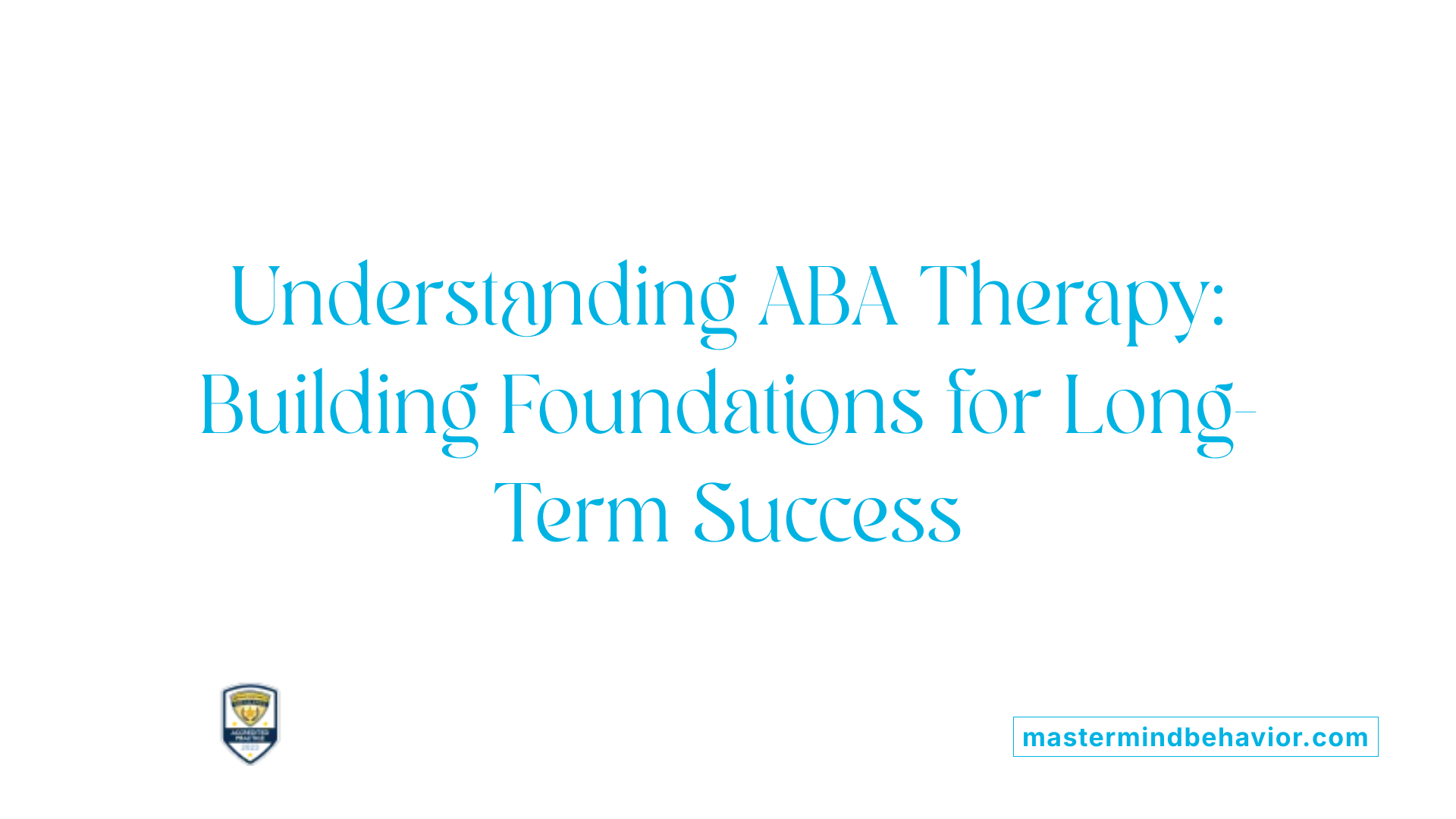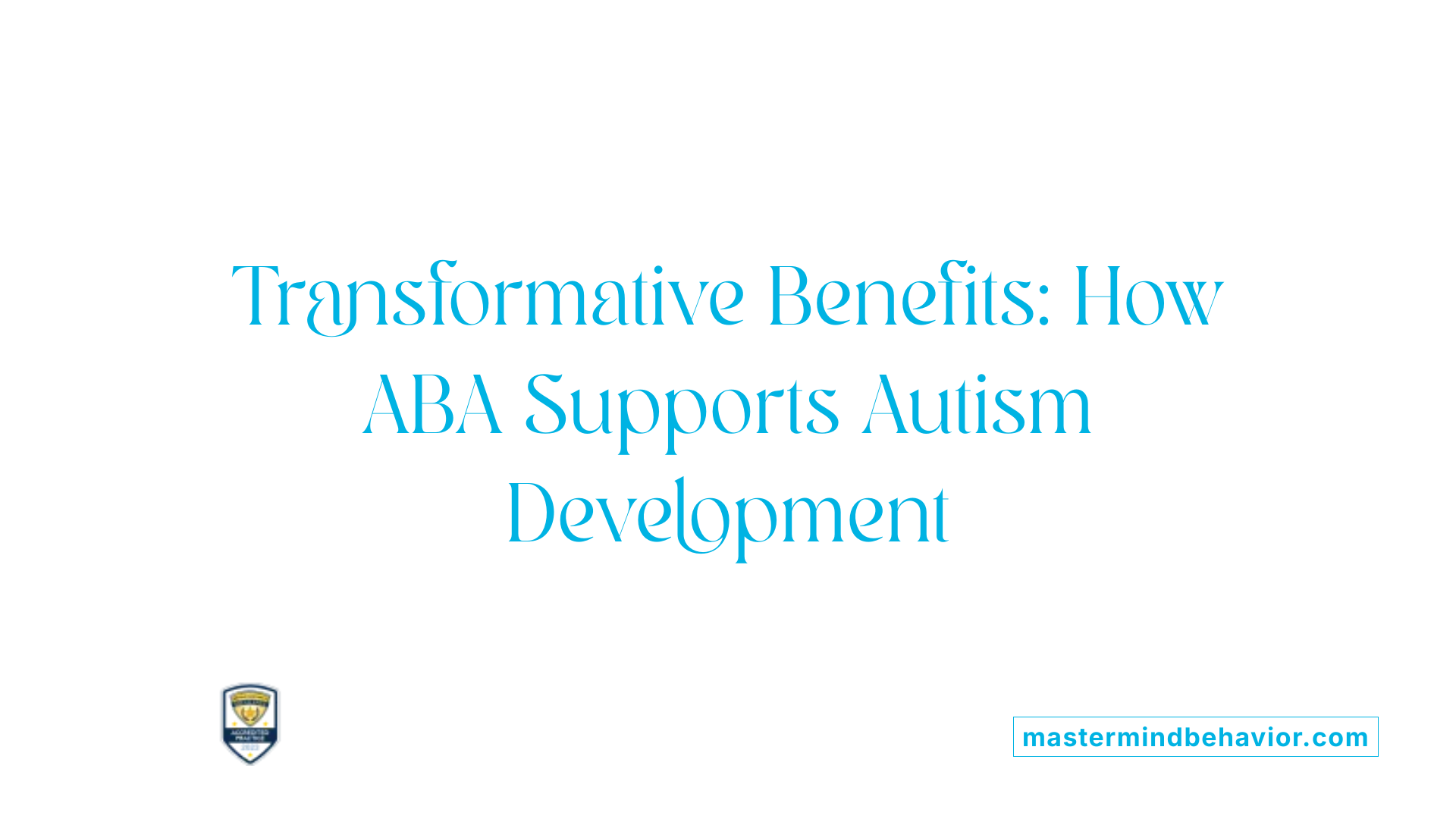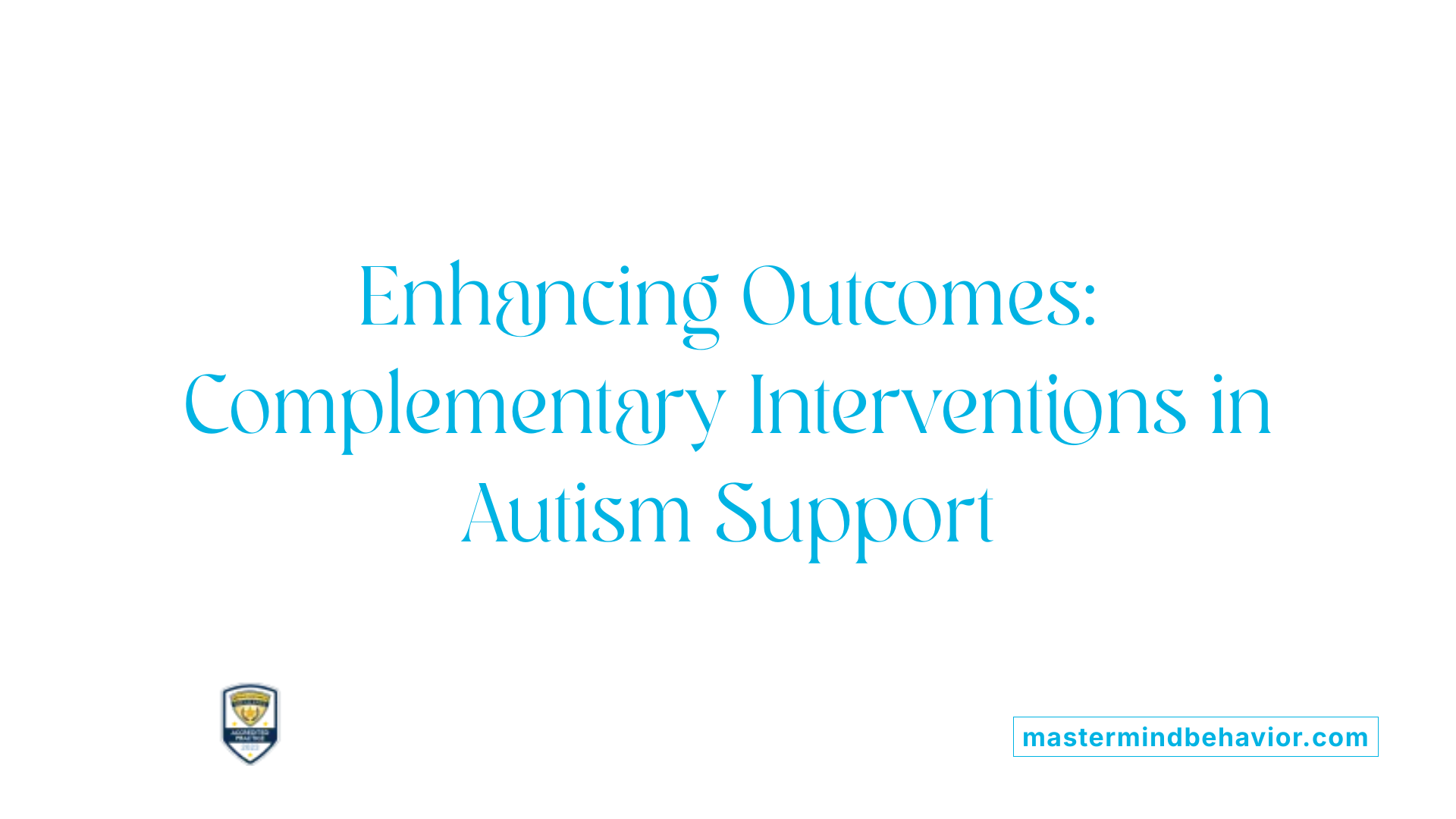Understanding ABA Therapy's Role in Autism Support
Applied Behavior Analysis (ABA) therapy stands as a cornerstone intervention for individuals with autism, especially in guiding long-term planning and goal achievement. Grounded in scientific principles, ABA customizes interventions that improve essential skills, from communication to self-regulation, allowing meaningful progress over time. This article explores how ABA therapy supports behavioral and developmental growth, the methods employed, the qualifications of providers, and addresses important considerations regarding its use.
What is ABA Therapy and How Does It Support Long-Term Planning in Autism?

What is Applied Behavior Analysis (ABA) therapy and how is it used to support individuals with autism?
Applied Behavior Analysis (ABA) therapy is a structured approach that examines a child's specific functional challenges to develop behavioral plans. These plans aim to improve adaptive skills and reduce inappropriate behaviors by using systematic observation and data collection.
How does ABA therapy help set and achieve long-term goals?
ABA therapy focuses on creating a clear roadmap through personalized, specific, and measurable goals. These goals steer interventions and track progress over time.
What behavioral areas does ABA therapy target?
Common goals include enhancing expressive and receptive language skills, improving social interaction with peers, decreasing maladaptive behaviors, and increasing self-regulation abilities. This broad focus supports both communication and social development as well as behavioral management.
How are behavioral plans structured and how is progress measured?
ABA employs techniques such as reinforcement, prompting, shaping, and fading to modify behavior effectively. Data collected during sessions helps tailor interventions, making sure they meet the child's unique needs and allowing for adjustments based on progress.
What role does family involvement and individualized intervention play?
Family participation is essential in ABA therapy. Parents receive training to respond appropriately to their child's behaviors, reinforcing skills learned in therapy sessions. This individualized approach ensures that strategies are relevant to the child's daily environment and supports continuity in learning.
By integrating structured behavioral planning with involvement from caregivers, ABA therapy provides an evidence-based framework to promote long-term improvements in communication, social skills, and adaptive behaviors for children with autism.
Key Methods and Techniques Employed in ABA Therapy for Goal Achievement

What are some common methods or techniques used in ABA therapy?
ABA therapy utilizes a variety of structured methods to help children with autism learn new skills and reduce inappropriate behaviors. One widely used technique is Discrete Trial Training (DTT), which breaks skills into small, manageable steps taught through repeated, clear trials with reinforcement to encourage correct responses.
Another approach is Natural Environment Training (NET), where learning takes place in everyday settings, allowing children to apply skills in real-world contexts naturally. This method supports generalization and spontaneous use of the learned behaviors.
Behavior chaining involves linking together a sequence of simple actions to complete a complex task, improving autonomy. To support skill acquisition, therapists often use prompting to guide desired behaviors and then gradually remove prompts (called fading) to promote independence.
To increase positive behaviors, ABA heavily relies on positive reinforcement, which rewards desired actions. Conversely, extinction procedures help reduce challenging behaviors by withholding reinforcement for those behaviors.
Visual methods like modeling—including video and picture exchange communication systems—also play a critical role in facilitating understanding and social communication.
Throughout therapy, practitioners collect data on behavior patterns and responses using the ABC (Antecedent, Behavior, Consequence) framework. This data-driven approach ensures that interventions are tailored to each child's unique needs and progress is closely monitored for continuous improvement.
Behavioral and Developmental Benefits of ABA Therapy in Autism

How does ABA therapy benefit individuals with autism in terms of behavioral and developmental improvements?
Applied Behavioral Analysis (ABA) therapy offers meaningful advancements for individuals with autism by focusing on enhancing communication and social skills. Through structured approaches, ABA supports both expressive and receptive language development, enabling individuals to better understand and express themselves. This improvement in communication lays the foundation for more appropriate and successful interactions with peers and adults.
In addition to language, ABA therapy systematically targets social skills, encouraging positive peer interactions and social engagement. By using reinforcement techniques alongside prompting and shaping, therapists can reduce maladaptive behaviors such as irritability, aggression, or repetitive actions. This reduction leads to improvements in emotional regulation, making it easier for individuals with autism to navigate everyday situations.
Another crucial aspect of ABA is promoting independence and self-regulation. Therapy goals often include teaching self-care routines, problem-solving, and adaptive skills necessary for daily living. These targeted skills enhance the individual's ability to function more autonomously in various environments, from home to school.
The gains achieved through ABA therapy contribute significantly to an overall better quality of life. This holistic enhancement encompasses improved social functioning, reduced behavioral challenges, and greater emotional well-being. Such progress is measurable through specific, personalized goals and ongoing data collection tailored to the individual's needs.
Strong evidence supports ABA therapy’s effectiveness. Extensive research demonstrates its success in delivering sustained behavioral and developmental improvements. The therapy’s evidence-based, systematic approach ensures interventions are individualized, maximizing positive outcomes across key areas like communication, social interaction, and behavior management.
Who Provides ABA Therapy and What Qualifications Ensure Quality Care?

Types of ABA Providers
ABA therapy is typically delivered by a team of professionals with varying levels of expertise. The primary providers include Board Certified Behavior Analysts (BCBAs), who design and oversee treatment plans. Supporting them are Board Certified Assistant Behavior Analysts (BCaBAs) and trained behavior technicians who implement therapy under supervision.
Required Education and Certifications
Providers generally hold graduate degrees in psychology, education, or related fields with specialized training in applied behavior analysis. Certification such as BCBA or BCaBA confirms their competency and adherence to ethical standards. These credentials are critical indicators of quality and reliability.
Experience with Autism Spectrum and Developmental Disabilities
Effective ABA therapy relies on providers’ direct experience working with individuals on the autism spectrum or those with developmental disabilities. This hands-on background enables them to tailor interventions sensitively and effectively to each child's unique needs.
Importance of Family Involvement
A collaborative approach involving families is essential. Qualified providers actively engage parents and caregivers in therapy planning and skill generalization, ensuring that improvements extend beyond clinical settings into everyday life.
Supervision and Ongoing Professional Development
Robust supervision and continuous professional education are vital to maintain high-quality care. Experienced BCBAs oversee treatment implementation by technicians, while providers regularly update their knowledge of best practices, ensuring their approaches remain evidence-based and effective.
Addressing Criticisms and Limitations of ABA Therapy
Are there any limitations or criticisms of ABA therapy in the treatment of autism?
ABA therapy is widely used and effective, but it has faced some criticisms and limitations worth considering.
A common concern is that ABA can appear rigid, often focusing heavily on compliance and behavior modification. This focus might sometimes overlook the importance of genuine emotional connections and the child’s own intrinsic motivation. Critics argue that such an approach may prioritize reducing unwanted behaviors without fully addressing the underlying emotional or psychological needs.
The intensity and duration of ABA therapy can also be challenging. Many children undergo several hours of therapy weekly for extended periods, which can lead to stress both for the child and their family.
To address these concerns, many practitioners are now adopting more compassionate and personalized ABA methods. These evolved approaches aim to respect individual differences, ensuring behavioral goals do not overshadow the child's emotional well-being and personal needs. They seek a balance between effective behavior management and fostering intrinsic motivation, connection, and quality of life.
Overall, while ABA remains a cornerstone in autism treatment, ongoing refinement helps address these critiques and better support children’s diverse needs.
Complementary Interventions Supporting Long-Term Goal Achievement in Autism

How does speech and language therapy enhance communication in children with autism?
Speech and language therapy plays a crucial role in improving speech patterns and language comprehension. By targeting these areas, children with autism can develop stronger communication skills, which complements the social and behavioral improvements targeted by ABA therapy.
What role does occupational therapy play in daily living skills?
Occupational therapy addresses challenges in adaptive skills necessary for daily living, such as handwriting and self-care activities. This intervention supports children in gaining independence and functionality in everyday environments, enhancing their overall quality of life.
How does parent management training help manage behaviors?
Parent management training equips caregivers with strategies to respond effectively to problematic behaviors while encouraging appropriate behaviors. This training is integral to a comprehensive intervention approach, ensuring consistency and support outside of formal therapy sessions.
What are the benefits of special education services under an Individual Education Plan (IEP)?
Special education services tailored with an IEP focus on addressing social communication difficulties, restricted interests, and repetitive behaviors. Customized schooling accommodations and specialized classes provide children a supportive learning environment that promotes academic and social development.
How is coordinated care important for co-occurring conditions?
Children with autism often experience co-occurring issues such as insomnia, ADHD, anxiety, and depression. Coordinated care involving therapy and medication management—including the use of medications like aripiprazole and risperidone prescribed by child psychiatrists—helps reduce symptoms and supports overall treatment effectiveness.
Together, these complementary interventions work in tandem with ABA therapy to foster comprehensive growth and support for children with autism, targeting communication, adaptive skills, behavior, educational needs, and mental health.
Maximizing Impact of ABA Therapy for Long-Term Success
ABA therapy serves as a foundational tool for teaching long-term planning and achieving meaningful goals in individuals with autism through customized, evidence-based interventions. By employing diverse techniques and emphasizing measurable outcomes, it fosters communication, social skills, and independence, while reducing problematic behaviors. The qualifications of providers and family involvement are crucial in sustaining progress. Recognizing criticisms helps refine practices toward more compassionate, individualized approaches. Supported by complementary therapies like speech and occupational therapy, ABA contributes to a holistic strategy that empowers individuals on the autism spectrum to thrive with tailored support across their lifespan.
References
- What Is Autism Spectrum Disorder?
- ABA Therapy Goals for Autistic Individuals
- Who Qualifies for ABA Therapy: Eligibility Guide
- Applied Behavior Analysis (ABA)
- The Top 10 Reasons Children With Autism Deserve ABA
- Applied Behavior Analysis (ABA)
- 6 Benefits of ABA Therapy for Children with Autism
- ABA Techniques: Strategies for Behavior Analysts - GSEP Blog









